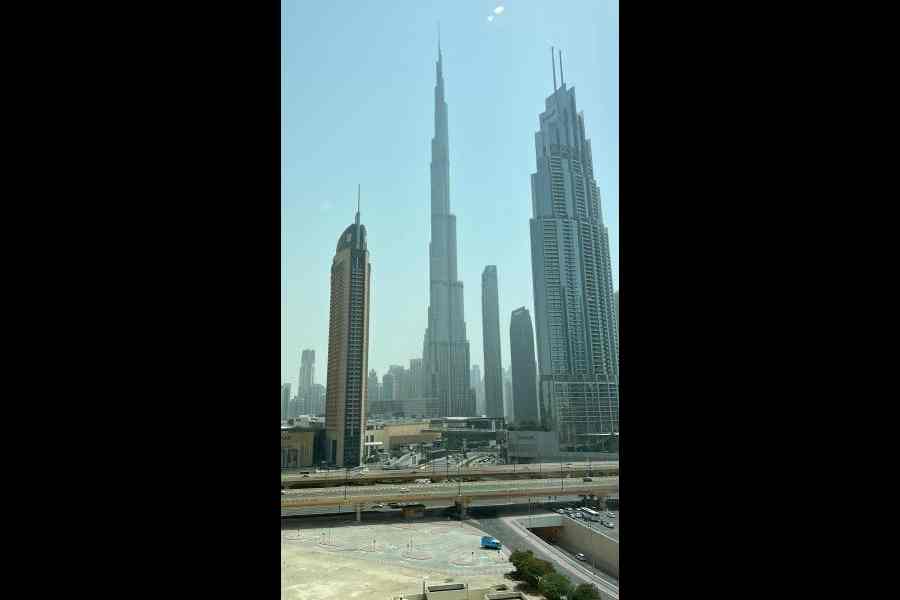I am obsessed with Tom Cruise. So, when a trip to Dubai came up a couple of months ago, around the time Cruise’s Mission: Impossible — Dead Reckoning Part One hit our screens, I couldn’t contain the excitement of travelling to the city of Burj Khalifa, which he had rappelled down more than a decade ago in a daredevil stunt for Mission: Impossible — Ghost Protocol and him casually perched on top of the world’s tallest building with a bird’s-eye view of Dubai in the background, now a part of folklore. This was the closest I felt I could get to the Hollywood icon. In spirit.
Lucky me my cosy room in Rove Downtown gave me a crystal clear view of the Burj, sending shivers of excitement down my spine. As I took in the beauty of the twinkling and majestic Burj from my room every now and then, I noticed that the city hardly sleeps. Dubai was not just the city of the Burj or desert safaris, I discovered many indoor gems that make Dubai a great destination for a summer visit too. Here’s revisiting a few of my favourite first-time bests from my trip that you can enjoy a whole lot more with friends and family.
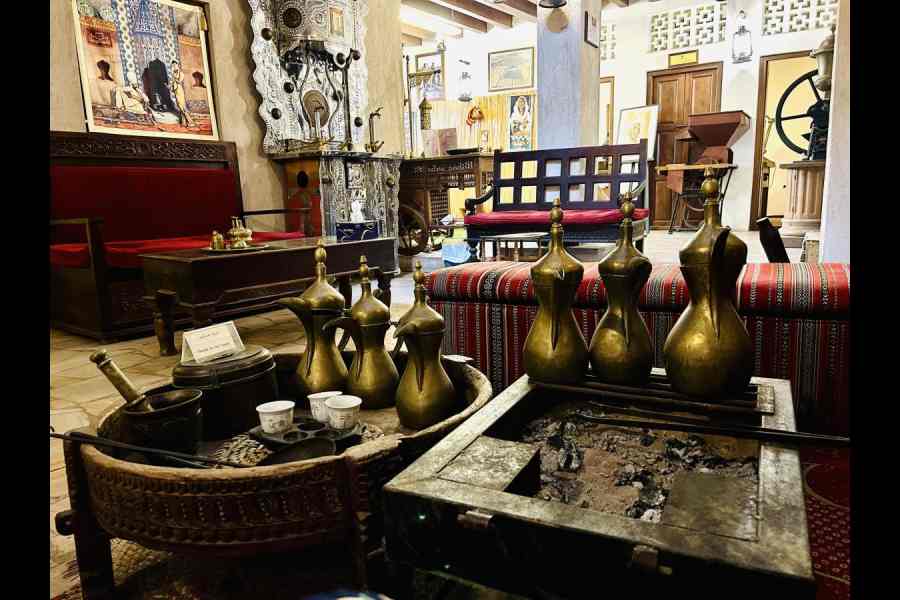
We tasted Arabic coffee at the Coffee Museum
Coffee Museum
Human passion knows no bounds and Dubai’s Coffee Museum at the Al Fahidi in Bur Dubai was one such tale of an impassioned Khalid Al Mulla, who set up ‘the first coffee museum in the MENA region’ in 2014. Housed inside a heritage property so vintage that it permeated into your senses like a sweet lingering perfume.
The aroma of coffee hung in the air. We were treated to Arabic coffee (the roast profile), which had a hint of cardamom, that was supposed to be savoured with dates. A cup of Ethiopian coffee followed, which we were told was often savoured with popcorn, among other things. Strong with caffeine.
A tour of the place, which is spread over two floors, threw up interesting nuggets about the widely loved beverage and the sheer volume of information and the collection is mind-boggling, ranging from the origins of coffee, its history and how it had evolved. Several eye-catching antiques were a testament to Khalid’s continued pursuit.
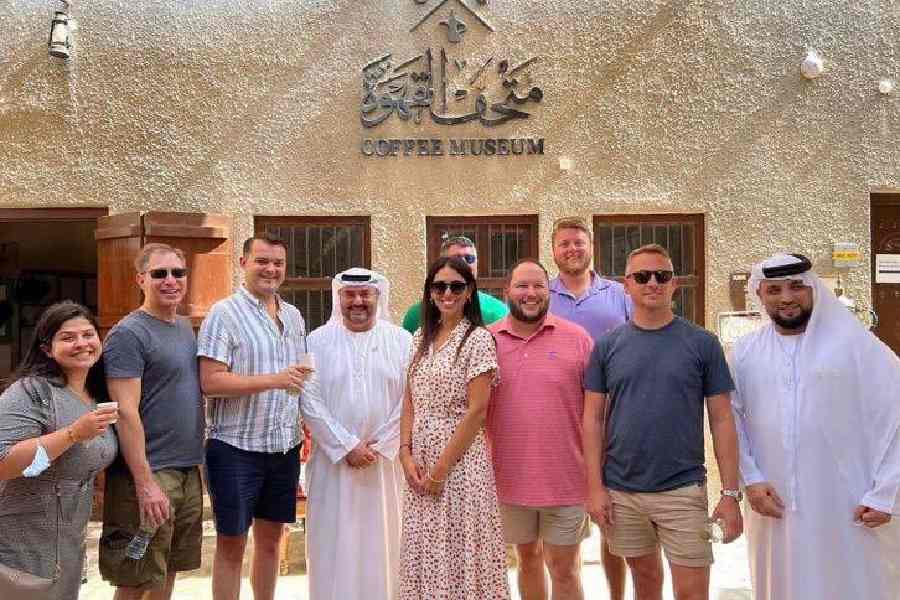
A part of Khalid Al Mulla's treasure trove of a collection
We listened to our bubbly host Cheryl, a barista, in wonder, as anecdotes rolled off her tongue.
Later, Khalid Al Mulla, owner of Coffee Museum, chatted with t2oS about his endeavour.
How was the Coffee Museum conceived?
The coffee museum opened its doors in 2014, and the idea for it came two to three years prior to that when I visited a coffee event in Hamburg (Germany). So, I listed places I wanted to go to. One of the places was the coffee museum in Hamburg and at that time I was a collector of coffee. And when I saw the coffee museum, I knew I wanted to create something like that back home.
The huge collection that we see, how much time did it take for you to put it together?
It took me 12 years-plus. I am still a collector, so whenever I travel to any country I go and buy a piece. So this year I got a piece from Greece and last year from different parts of the world including Italy. Most of the items here are from Germany and from people who’ve gifted me since they know I own a coffee museum.
Can you take us through some of your most prized possessions? What are some of the rare pieces that you have in your collection?
Okay, so the three oldest pieces I have at the museum are a coffee roaster that dates back to the Ottoman Empire in the 16th century, a grinder from Naples, Italy, dated 1725, and a book published in 1785.
What has the response been like ever since you opened?
There has been a huge interest from the local and international media, even from the coffee media and tour companies and the Dubai Tourism Board. It was placed in the top 100, then 25 and now the top 10 places to visit in Dubai. Plus the tour companies put the coffee museum as part of their tour programme. We have over 200 nationalities and most are coffee drinkers, so obviously everybody loves to drink coffee, so it has been a huge positive. I haven’t spent much on marketing, so the business just came to us. Also, the Al Fahidi Historical Neighbourhood is a tourist attraction in Dubai, so the coffee museum is a must-visit whenever visiting the area.
What is the most interesting thing about coffee that you have read about?
There are so many interesting things such as the environment, coffee farms, sustainability, how to maintain a coffee farm and the family involved in cultivating coffee. It is a simple life but at the same time it is the second strongest commodity after oil and it is the most consumed drink after water and it is a social, economic and political aspect of our life.
How do you like your coffee?
Filtered, in the coffee world also known as pour-over coffee, as the brewing method is easy.
Will you be adding more to the collection?
Yes of course, always. The tour usually takes over an hour to two hours, so whenever I am taking people on the tour, I tell them that I have gotten this piece from this country and I hang it in my museum. So I have unique pieces which I haven’t placed in the museum yet, but I try to utilise every corner in the museum. So it’s very hard to add more yet. There are a few more pieces in my mind and I’m trying to procure them.
Do you want to replicate it elsewhere too?
Yes indeed, I have talks with different cities in UAE and there is great potential (of a) similar project. There is huge interest. I really want to replicate it if there is interest from any other country.
Dubai Aquarium & Underwater Zoo
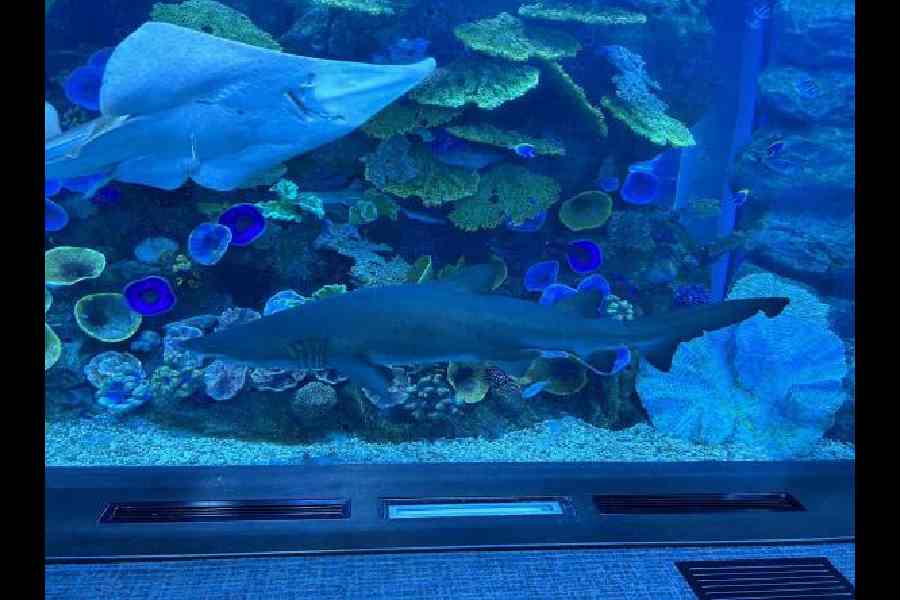
Dubai Aquarium & Underwater Zoo
The second day began with a trip to the Dubai Aquarium & Underwater Zoo housed inside the Dubai Mall, the size of a mini city. A tunnel led us into the Dubai Aquarium tank and as you passed through it, you were escorted through your journey by the most exquisite marine creatures. While you paid them a visit, they also stopped by for a meet and greet!The Aquarium was spread over two levels and the second level led to the Underwater Zoo, which was divided into three ecological zones — Rainforest, Rocky Shore and Living Ocean — making for a complete amidst-nature experience. There were various species of fish, other aquatic creatures, reptiles and birds that made for an immersive observation. And, though the False Cobra gave us the chills, we still saw it in the eye and went click-click!
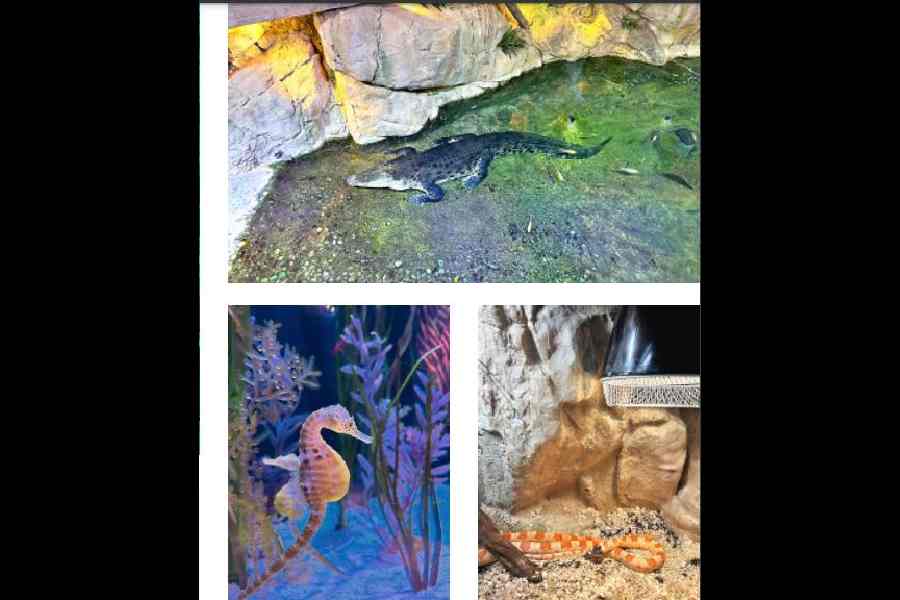
Museum of the Future
The Museum of the Future, ‘a gateway to a future world’, was our next stop, our very own space odyssey, set in 2071. We boarded Mohammed Bin Rashid Spaceport and zoomed off into ‘space’. Interactive and immersive, it’s a great experience for those interested in the space and its workings. The architecture of the building was signature and striking, the facade ‘a canvas for the quotes of His Highness Sheikh Mohammed Bin Rashid Al Maktoum rendered in the calligraphy of Mattar bin Lahej’. While the ‘recreation of the Amazon rainforest’ was beautifully soothing, the ‘DNA library of thousands of species’ was breathtaking, full of drama and easily our favourite.
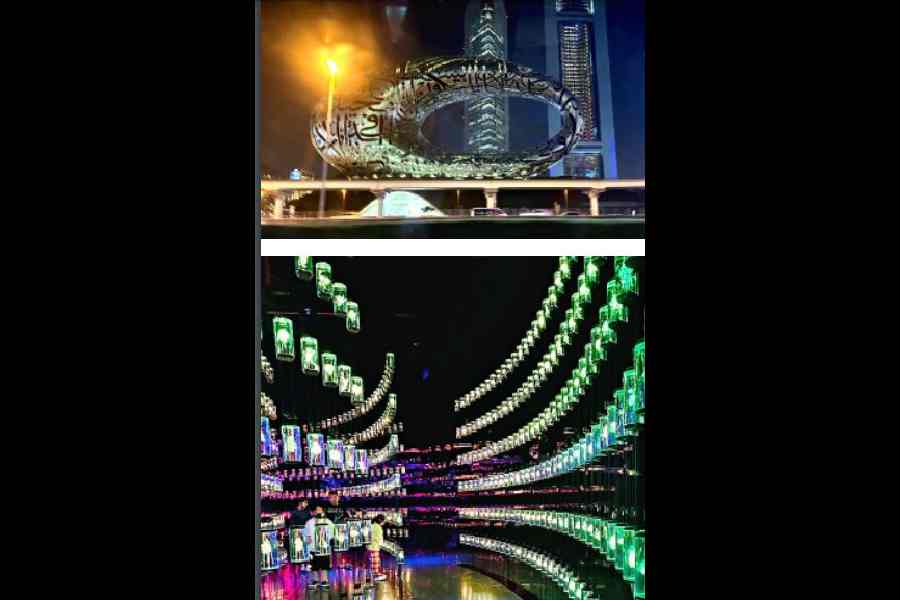
Museum of the Future
Top tip:
The view from the sky deck is simply irresistible, but make sure you slather yourself with sunscreen before you step out.
Blacklight Minigolf

The entrance to the Blacklight Minigolf
Glow-in-the-dark golf seemed intriguing and challenging to begin with. We put on our 3D glasses and picked up our golf sticks and putted around several rooms, surrounded by beautiful ‘UV-fluorescent paint’ art. The difficulty levels had been innovated with, to make your experience exciting and competitive. A great way to gauge one’s patience levels too, we say.
Top tip:
Keep your belongings in a locker as you don’t want to be lugging around a bag while struggling with your golf stick, in darkness. It might take you a bit of time to adjust to the semi-darkness, so relax and soak it all in before you unleash the Tiger Woods in you.
Avatara
A 15-course vegetarian meal was a perfect send-off. We dined for around two hours at the Michelin-star restaurant Avatara. Bombed by flavours is perhaps the best way to describe the experience. Indian food served with a thriller of a twist.
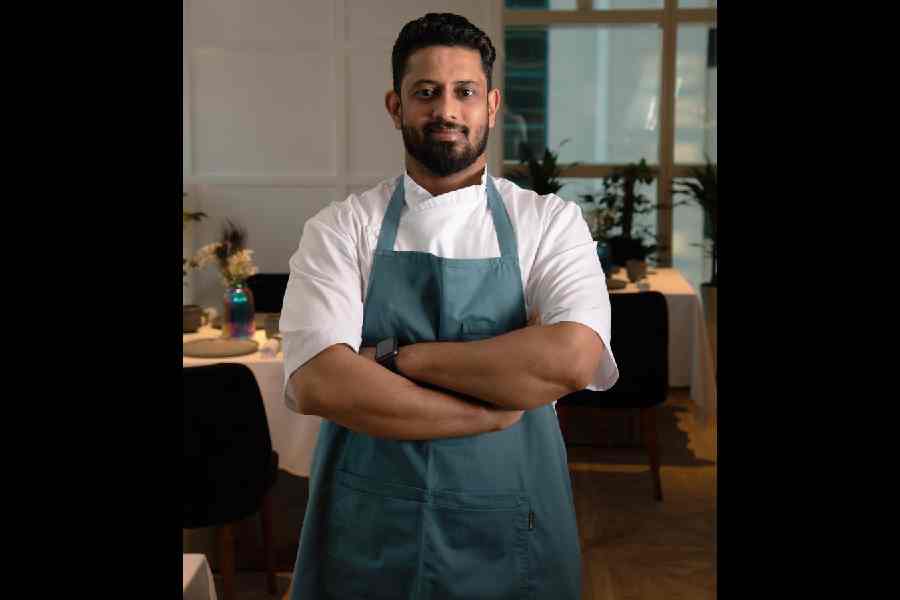
chef Rahul Rana
Full marks and more for presentation, with each dish being decoded as it was being served. The team took turns to explain the concepts as you captured the moments. They even had tips for you on how to enjoy it best. The beautiful menu card came with detailed notes on the ingredients, a slice of Indian mythology and health benefits.
We loved the understated vibe of the whole restaurant. There was a wall dedicated to messages in wine bottles, a collection from the connoisseurs who opted for a wine pairing menu and we spotted Virender Sehwag’s!

A glimpse of Avatara
Top tip: You can take a break in between if you wish to (trust me, you would need it!) but you have to notify the team at least one course in advance because there should be no time lost between plating the food in front of you and you gobbling it down! They want to serve the food at the right temperature and also avoid wastage.
t2oS later caught up with chef Rahul Rana of ‘Dubai’s first and only all-vegetarian degustation fine-dining experience’.
We had a brilliant meal at Avatara and were blown away by the innovative fusion. How did you arrive at the name and the concept?
In 2019, Tresind Studio was serving the Sasya menu, a plant-based menu focused more on the vegetarian side. During that time, chef Himanshu and I thought about giving an experience to our guests by doing only a pure vegetarian degustation experience. Eventually, we worked on it and that’s how we came up with the concept of Avatara. The name ‘Avatara’ and the concept were carefully chosen to reflect our restaurant’s philosophy. ‘Avatara’ comes from the Sanskrit word ‘avatar’, which means ‘incarnation’ or ‘manifestation’. Our concept revolves around manifesting vegetarian Indian cuisine, combining various culinary influences to create a unique vegetarian fine-dining experience.
We are sure the most common reaction you get from your guests is one of pleasant surprise! What has been memorable feedback till now?
Our first guest at Avatara said that we match Eleven Madison Park standards regarding food, presentation, and service. This was our biggest compliment on the opening night.
Is there a reason you chose to go with vegetarian cuisine?
We chose to focus on vegetarian cuisine for several reasons. Firstly, vegetarian dishes can be as exciting and flavourful as their non-vegetarian counterparts. Secondly, we wanted to cater to a diverse range of diners, including those with specific dietary preferences and those seeking healthier dining options. Our commitment to sustainability and reducing environmental impact also influenced our choice.
How do you go about curating the menu?
Curating our menu is a dynamic process that involves continuous experimentation, research, and collaboration among our talented team of chefs. We draw inspiration from various culinary traditions and ingredients, seeking to blend flavours, textures, and presentation harmoniously. We aim to surprise and delight our guests with each dish while maintaining a cohesive and balanced dining experience.
Where do you procure most of your items from?
We take pride in sourcing the finest and freshest ingredients for our dishes. Our procurement process involves partnering with local farmers and trusted suppliers who share our commitment to quality and sustainability. By sourcing locally, we also support the community and reduce our carbon footprint.
How tough is it to take the innovation level a notch higher every single time?
Maintaining a high level of innovation is indeed a challenge, but it excites and motivates us. Our team constantly explores new ingredients, techniques, and global culinary trends. We encourage a culture of creativity and open-mindedness, allowing us to push the boundaries of traditional cooking and consistently offer our guests something new and exciting.
The presentation itself is half the battle won...
Presentation is indeed a crucial aspect of our dining experience. Visually appealing dishes enhance the overall enjoyment of the meal. Our chefs take great care in artfully arranging each work to be a feast for the eyes before it becomes a feast for the palate. For example, we have included some least favourite vegetables, like bottle gourd, bitter gourd, etc., that we present uniquely.
How much in advance do you have to reserve your meal?
We only do two seatings in a day and recommend making a reservation in advance. However, we do accept walk-ins as well, depending upon the availability.
We have a feeling, the Avatara kitchen is almost like a science lab! Tell us about your team.

(l-r) Virender Sehwag’s message for the team, Naivedhya, Krishna Phal (passion fruit)
Our kitchen is indeed a dynamic and innovative space, resembling a science lab in some aspects. Our team of chefs comes from diverse culinary backgrounds and brings a wealth of knowledge and creativity to the table. They work together seamlessly, collaborating on new dishes, refining techniques, and elevating the overall dining experience.
A Michelin star is fabulous. What has it added to Avatara?
Earning a Michelin star was a tremendous honour for Avatara. It has added a new level of recognition and prestige to our restaurant, attracting even more diners worldwide. The Michelin star has also motivated our team to maintain the highest standards of culinary excellence and continue pushing the boundaries of innovation.
What’s your comfort food?
Chole Bhature is my comfort food, and I have created an Avatara version of this dish which is called Dalika (Lentils) — horse gram curry, ragi bhatura and jakhiya aloo.
What are your plans with Avatara?
Avatara is going through some exciting changes and expansions. Avatara is moving to a new place in Dubai, which could mean new opportunities, a different ambience, and a more extensive customer base. The restaurant is revamping its menu, offering customers new and possibly innovative dishes. This change might attract more patrons and keep existing ones excited about trying something fresh. Avatara is catering to families by adding a dedicated kid’s tasting menu. Avatara plans to open a new restaurant in Mumbai by the end of the year.
WHAT WE FEASTED
Naivedhya
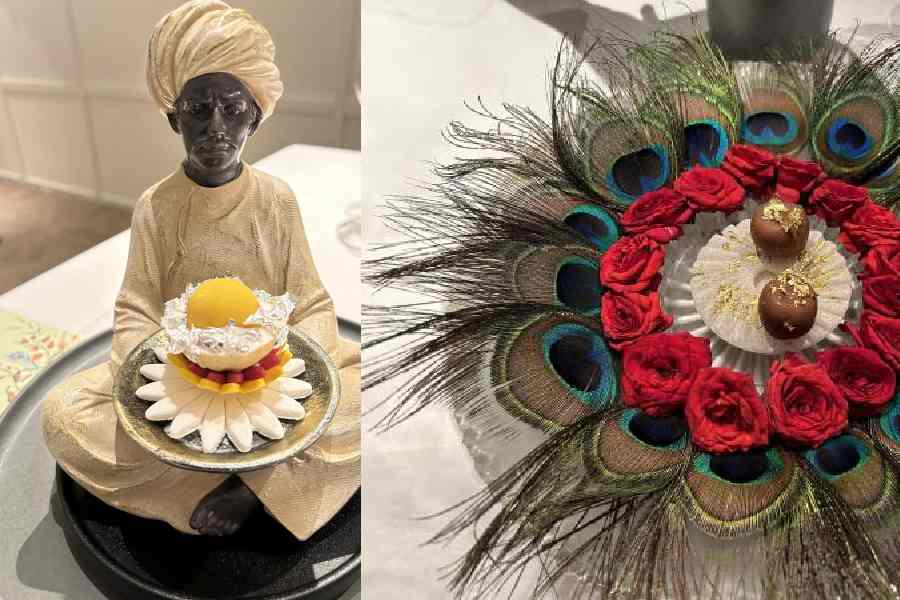
(l-r) Ksheer (kheer/pudding), Paan Bonbon
Uddipaka (aperitif)
Raktphalam (tomato)
Jadon (roots)
Badak (vada): Dal Vada +ß Carrot Kanji + Black Lemon Pickle
Karuvelvilas (bitter gourd)
Sandhita (pickle): Achari Broccolini, Tomato Relish, Crispy Kale
Panasa (jackfruit)
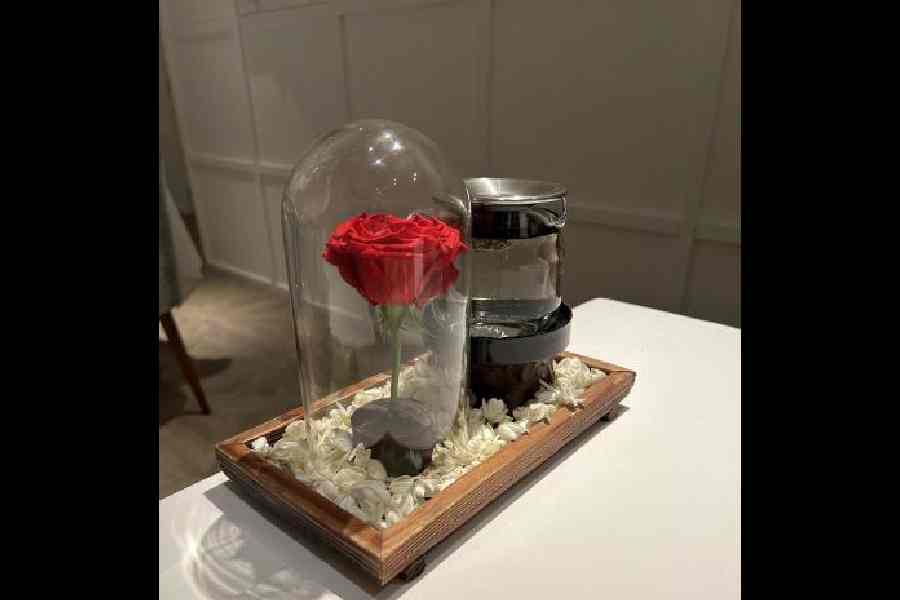
Jasmine and lychee tea
Krishna Phal (passion fruit)
Grinjanah (turnip)
Dalika (lentils)
Ksheer (kheer/pudding)
Madhuram (sweet)
Parna (betel leaf)
Pushpanjali (flower): Jasmine and lychee tea
